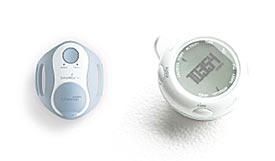SenseWear display details daily activities, helps motivate patients
Monitoring device advancement tracks calories burned, sleep efficiency and physical activity.
Physicians and patients now have a product that provides access to personal health information, such as number of calories burned, physical activity duration and sleep duration. The product may aid in the prevention of chronic lifestyle-related conditions such as obesity, diabetes and cardiovascular disease.
BodyMedia Inc. launched the SenseWear display, a new advancement to the SenseWear Body Monitoring System, at the American College of Cardiology Scientific Session 2007 in New Orleans. The information provided by the system helps identify patient behaviors that best promote weight loss and healthy living.
“We’re facing an epidemic of obesity in this country, and changing our approach is very important,” said Michael Davidson, MD, director of preventive cardiology and a clinical professor of medicine at the University of Chicago.
“We know from large trials that one of the most important aspects of losing weight and maintaining weight loss is exercise and, therefore, a device that can potentially give a person feedback about the number of calories utilized for exercise would potentially be a valuable addition to an overall weight reduction program,” said Davidson, a member of Cardiology Today’s Preventive Cardiology section.
Many patients lack an accurate monitoring system to help keep them motivated to lose weight. At times they may even misjudge their activity level. This product provides patients with an objective way to look at their daily lifestyle and evaluate a potential need for change.
Benefits of use
“We have developed a pioneer metabolic assessment and behavior therapy technology that monitors and delivers accurate, objective health metrics in real time to enable clinicians to offer personalized education and therapeutic treatment to their patients,” said Donna Wolf, PhD, clinical research manager at BodyMedia.
How it works
|
Source: BodyMedia Inc. |
The SenseWear display is a wireless communicator that captures and displays data transmitted by the SenseWear Body Monitoring System armband. Patients can wear the display on the watchband or on their clothing, and receive up-to-the-minute reporting of total energy expenditure, moderate to vigorous physical activity duration, and number of steps.
The display keeps patients engaged in improving their health by providing this feedback and helps patients track their progress against personal fitness targets. It also records key health metrics during individual daily workouts and other activities. The device provides target ranges, and when a patient reaches their target goal, the device sends a message congratulating them, according to Wolf.
“We feel that this display device has enhanced the quality of the product; it makes it easier for self-monitoring activities and provides people with information to change their lifestyle,” she said. “It is an enhancement to the solution we already have.”
Using the armband, clinicians can assess their patients by estimating their energy expenditure. The device is compact and lightweight in design, therefore minimizing interference with the patient’s day-to-day activities. The armband can hold up to 14 days of continuous data before it must be uploaded to a computer, and it is water-resistant. Its four sensors track and record body movement, galvanic skin response, skin temperature and heat fluctuation.
“This is the only product that combines four sensors that accurately measure temperature and duration of physical activity as well as sleep, so it’s the most accurate body monitoring system available for daily, normal activities” Wolf said.
The FDA approved the SenseWear Body Monitoring System in 2003 as an exemplary device. It is indicated for people who are overweight, obese or have diabetes or CVD. The SenseWear Body Monitoring System and display can be purchased on BodyMedia’s website and is available worldwide. The cost is currently not reimbursed by insurance companies, according to Wolf.
Validation study
A validation study published in March issue of The American Journal of Clinical Nutrition, compared the SenseWear armband to the doubly labeled water method, which is considered the “gold standard” for measuring energy expenditure in free-living conditions. Researchers conducted this study over a 10-day period among 45 participants with normal weight or obesity and type 2 diabetes. Results suggested the SenseWear armband is an accurate metabolic monitoring device for free-living.
“The researchers found similar accuracy, with about an 8% error off of the gold standard,” Wolf said.
More recently, results of an outcome study, published in the April issue of Obesity, found the SenseWear system, when combined with a standard weight loss program, significantly enhanced weight loss 2% to 3% among obese and overweight individuals who participated in the 12-week study, according to Wolf.
“More research is necessary to validate this tool in both larger and longer-term clinical trials,” Davidson said. “Although the data appears to be preliminary and based on relatively small sample sizes, this device does show some promise in increasing weight loss.”
An estimated 10 additional studies are currently underway to examine a variety of issues with the SenseWear Body Monitoring System and display, according to Wolf. She expects publication of the results of one study on the product’s benefits of use with diabetes education and treatment adherence by the end of 2007. Other studies, with data slated for publication in 2008, will focus on cardiovascular and obesity issues.
“[The product provides] a way for clinicians to assess the behavior that impacts their patients’ diseases so the clinician can educate them on their behavior and show them how to change and monitor their progression and disease management plan,” Wolf told Cardiology Today. “Patients really become informed about their own bodies so they can truly modify their behaviors.” – by Tara Grassia
For more information:
- Visit www.bodymedia.com/products/bodymedia.jsp.
- Polzien KM, Jakicic JM, Tate DF, Otto AD. The efficacy of a technology-based system in a short-term behavioral weight loss intervention. Obesity. 2007;15:825-830.
- St-Onge M, Mignault D, Allison DB, Rabasa-Lhoret R. Evaluation of a portable device to measure daily energy expenditure in free-living adults. Am J Clin Nutr. 2007;85:742-749.

